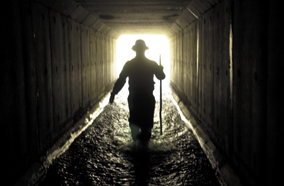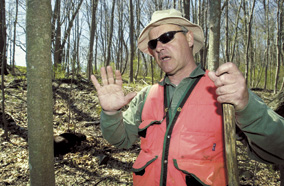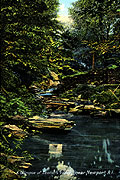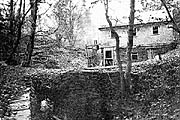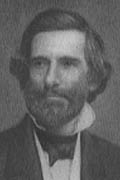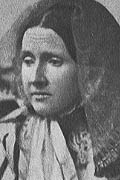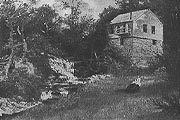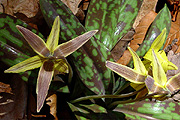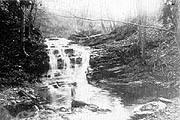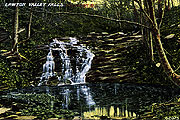|
|||
| Enchanted Forest[1] By James A. Johnson/Daily News staff PORTSMOUTH - A relatively unknown and nearly pristine forest in Portsmouth is getting serious attention as an environmental gem that should be preserved.
The Lawton's Valley Forest, part of Lawton's Valley Canyon at the south edge of Raytheon Co. on West Main Road, contains an assortment of species that are rare to Aquidneck Island or even southern New England. The forest starts on the east side of West Main Road and follows Lawton's Brook, which runs for about a mile and empties into Narragansett Bay. "This could be one of the oldest forests ever found in Rhode Island," said arborist Matthew Largess of Jamestown. "It's a jewel." What makes it a jewel, Largess said during a forest tour earlier this week, is the varied species of trees, many of which are rare and very old.
Walking into the forest, a visitor sees the many and varied trees reaching high toward the blue sky. Buds are getting ready to open. The ground is covered with a thick layer of dead, brown leaves that crunch underfoot. There is little brush evident, which Largess said is a sign of an old forest. The brook rumbles over rocks and logs in its path. Farther down, the rumble gets louder as the water tumbles down a waterfall. The brook meanders for almost a mile through the tree-lined canyon before it empties into Narragansett Bay. Its mouth is about 200 feet lower than where the canyon begins. One of Largess's biggest finds was a sugar maple, which he said was probably the largest sugar maple left in the wild in New England. He measured its circumference at more than 13 feet. At 12 feet, a sugar maple is considered a champion tree. "These types of sugar maples don't grow anywhere else in southern New England," he said. The tree has to be more than 300 years old, and could be as old as 500, Largess said. Although the top of the tree has broken off, limbs on it are still living. "This whole area is full of sugar maples," he said. "There are generations here." Largess said the forest is probably one of the rarest ecosystems on the East Coast. At one time, the forest was the home of Julia Ward Howe, author of "The Battle Hymn of the Republic." Largess discovered it about five years ago and has been studying it ever since. He said this forest once was connected to Oakland Forest, which he helped to protect when it was threatened with development several years ago. Largess hopes to interest the National Park Service and to have the forest named a National Park Landmark. It would be the first in Rhode Island. He said he hopes the land can be added to the Aquidneck Island Land Trust. The canyon is owned by Raytheon, the owners of the housing complex to the south and the Navy. Largess is not alone in his preservation efforts. The Rhode Island chapter of the Sierra Club, the Appalachian Mountain Club and the Raytheon Environmental Wildlife Habitat Committee joined forces for a forest cleanup last Saturday. About 40 people spent the day cleaning up the area. Although the volunteers didn't know each other, they worked together and took out tons of trash from the area, said Brenda Bibb, Raytheon's environmental health and safety coordinator. The canyon has a great deal of environmental value, she said. She saw wildflowers called trout lilies, which she hadn't seen in years, all over the valley, Bibb said. The committee has a postcard dated 1890 that shows the waterfall in the forest, she said. The card says Howe called the forest her "Garden of Eden." Linda Cooper, state outing chairwoman for the Sierra Club, said the forest provides a habitat for varied plant and animal wildlife. Some cleanup volunteers formed a chain to take debris through a tunnel that carries the brook under West Main Road, she said. "While we were there another time, an owl flew past us," Cooper said. "It took our breath away." An owl greeted Largess the first time he went into the forest about five years ago. He calls it the Grand Canyon of Rhode Island. Other factors make the forest special, Largess said. It is a climax forest, meaning it is healthy and it has new, middle-aged and very old trees. It also has never been plowed or cleared for farming. Other trees he pointed out included:
Largess said he could understand why Howe would make a homestead in Lawton's Forest. |
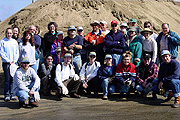 Earth Day Cleanup Crew at Staging Area Outside Lawton Valley © 2004, W. Saslow 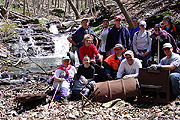 Earth Day Cleanup Crew in Front of Lawton Valley Falls © 2004, W. Saslow
|
| [Search!] | [Survey] [Planning] [Projects] [Outreach] | [What's New!] |
|
Copyright © 1999-2004, REWHC. All Rights Reserved 326 have visited |
||


